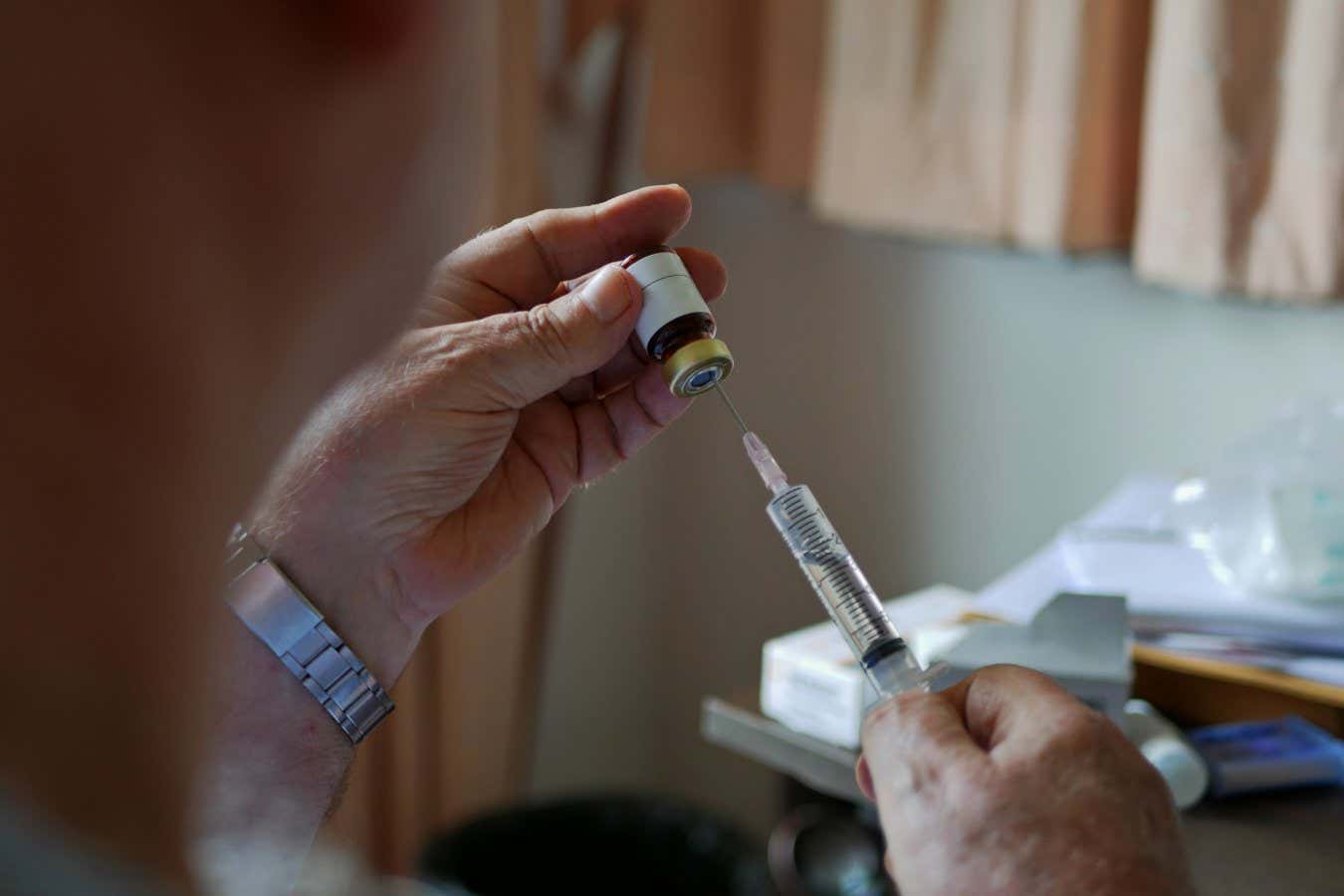
South_agency/Getty Images
If you have swiped through fitness-related content on Instagram, Facebook or TikTok lately, chances are that an influencer on your feed has taken steroids. A recent global meta-study estimates that steroid use in gym-goers ranges from 6 per cent in some countries to a staggering 29 per cent in others.
You might find this surprising, but Timothy Piatkowski at Griffith University in Australia says the culture around steroid use has shifted in the past decade, with many fitness influencers now openly disclosing their drug use and positioning themselves as experts who can help their followers take steroids for the best results.
“Unfortunately, the level of clinical knowledge and critical thinking varies quite significantly in these groups,” says Piatkowski.
The attitudes of these influencers towards health risks varies hugely, he says. A cursory look on Instagram shows that some influencers think the risks of steroid use are significant but can be intelligently managed; others label themselves “trenfluencers”, referring to their willingness to inject trenbolone, a steroid used to reduce muscle wasting in cattle during transport.
Millions of people looking to bulk up may be wondering if these substances really are safe or if influencers are luring them onto a dangerous path. What do we really know about the harms of steroids, and is there a safer way to take them?
Piatkowski says research on the long-term health risks of steroids is patchy, partially because there is a mismatch between the dosages and use patterns tested by scientists and those of real-world users. He and other researchers are trying to fill the gaps by working closely with steroid users to shape more relevant and realistic studies.
However, the mismatch has already provoked some influencers on social media to discredit mainstream scientific and medical positions on steroids, driving users to seek advice given in fitness and bodybuilding forums instead. These social media platforms have been a big contributor to the explosion in steroid use, acting as both a support network and a marketplace.
Users now have easy access to different drugs they could potentially illegally buy: from orally ingested steroids known as SARMS (selective androgen receptor modulators) to synthetic forms of human growth hormone, the stuff produced by your pituitary gland during puberty. As a group, they are referred to as image- and performance-enhancing drugs, though the mechanisms through which they work differ hugely.
The drugs used most prevalently are probably anabolic steroids, potent artificial derivatives of testosterone, with a 2022 study estimating that around half a million men and boys in the UK had used them for non-medical purposes in the previous year.
What steroids do
To know whether steroids are safe, we first have to understand what they do to the body. Anabolic androgenic steroids work by targeting receptors for hormones that promote the development of male sex characteristics, especially in muscle and bone tissue. “They build muscle, they’re important for bone growth, they take you through puberty and turn boys, literally, into men,” says Channa Jayasena at Imperial College London.
The desired effect is obvious: bigger, stronger bodies in a shorter time. Medically, some of these substances are prescribed to treat muscle-wasting conditions like HIV. At these lower doses, research suggests steroids can be well-tolerated. But that isn’t how they are typically used outside clinics.
Non-medical use of steroids rarely follows the cautious approach of clinical trials. Users often take “stacked” combinations of multiple drugs, cycle on and off the drugs to allow their body to recover or try “blast and cruise” regimens – large doses followed by lower ones. These practices aren’t well-studied in the scientific literature, but influencers claim they can help reduce health risks or better achieve desired outcomes on muscle growth. This may explain why many users end up seeking advice from influencers or online forums, rather than doctors.
Risks of unregulated use
Part of the appeal of taking experimental combinations of drugs or taking them in cycles is the belief that they help reduce the adverse side effects of anabolic steroids. The most well-established side effects are cardiovascular. Anabolic steroid use raises blood pressure and reduces high-density lipoprotein, or “good” cholesterol, in the blood while increasing low-density lipoprotein, or “bad” cholesterol. It also thickens the heart muscle, which can lead to cardiomyopathy, a reduction in heart function that can be fatal, says Jayasena.
A Danish population study found that anabolic steroid users had a threefold higher risk of death compared with other men during the period in which the study took place. “That’s the same as cocaine,” says Jayasena. Cardiovascular disease and cancer were the most common natural causes of death among these users.

Heart disease and an increased risk of stroke are among the most established side effects of long-term anabolic steroid use
3dMediSphere/Shutterstock
After cardiovascular health, Jayasena says that psychosocial effects are the most serious and well-documented. The phrase “roid rage” refers to verbal aggression, mania and psychosis experienced by some men who use high doses. “If you analyse the reason [why steroid users] are dying, there are three causes,” he says. “One of them is cardiomyopathy. One of them is suicide, but the other one is murder. So, we think that it predisposes men to criminality.”
That link remains contentious. It is hard to isolate steroid use from other factors, such as recreational drug use or pre-existing mental health conditions. Still, evidence suggests that stopping steroid use can bring on depressive episodes and suicidal thoughts – especially if the body’s natural testosterone production has shut down. “The testes get lazy,” says Jayasena. “They switch off, and it can take several months, occasionally years, to recover.”
A study led by Jayasena found that nearly 30 per cent of men who stopped using steroids experienced suicidal thoughts or major depression, probably because high levels of residual steroid linger in parts of the brain that regulate emotion. There is also evidence that steroids damage kidney function and increase cancer risk, but the data here is less certain, much of it based on individual medical case studies.
Some of these health risks seem reversible, according to a few studies. The liver, for example, is good at repairing itself and seems to tolerate lower, clinical doses of some steroids. Some effects like high cholesterol levels and high blood pressure also seem to be reversible after stopping steroid use, but others require prolonged or expensive treatment to fix, including mood disorders and infertility.
The most serious consequences of steroid use can be the hardest to treat. These include structural changes to the heart, with research showing that blood flow to the organ can be impaired for years after a user has stopped taking steroids.
‘Safer’ steroid use
With the long and complex list of potential harms, many users experiment with the ways they take steroids in a bid to reduce their risk. This includes adjusting dosages or timings, or using them in different combinations with other substances. Studies that look at the safety of these “protocols” are almost non-existent, says Piatkowski.
One of Jayasena’s studies found that post-cycle therapy, where users take medications that help restart natural testosterone production after completing a cycle of steroids, did significantly reduce the risk of suicidal ideation. One of Piatkowksi’s studies, comparing cycles where users take high dosages then taper off, showed that these blast-cruise users reported fewer negative health effects after stopping their usage.
High-quality, controlled studies on the effects of recreational steroid use are rare. They typically suffer from small sample sizes or take the form of reports on individual medical cases, making causal relationships difficult to pin down. The evidence base for specific protocols is even more scant, especially considering that the ways people use steroids are changing faster than officials and researchers can keep up with.

Anabolic steroids are often injected subcutaneously in the layer of fat that sits between the skin and the underlying muscle.
Ole_CNX/iStockphoto/Getty Images
“We need more longitudinal and cohort-type studies,” says Piatkowski – research that can track people’s health and well-being over time. That would help disentangle the real risks and perhaps offer guidance to reduce them. But without better evidence, doctors are often left in the dark on how to advise patients who use steroids.
Greg James, a clinician at Kratos Medical, a clinic in Cardiff, UK, that offers private health screenings and blood tests, says a few of his patients have even begun combining steroids with appetite-suppressing GLP-1 drugs and other peptides that regulate appetite. “They’re asking me if these peptides are safe,” says James. “And I’m saying, well, I’ve got nothing to go on. We have no long-term safety data.”
Faced with limited clinical data and fast-evolving user practices, researchers like Piatkowski are beginning to engage directly with users in real-world settings. Rather than viewing users solely as patients or outliers, this approach treats them as a source of lived experience – one that can help shape more relevant and realistic studies.
One study Piatkowski and his collaborators published this year analysed steroid samples sourced from users. More than 20 per cent were contaminated with toxic substances like lead, arsenic or mercury. Over half were incorrectly dosed, meaning users could have been taking much more potent agents, designed for fattening up cattle, for example.
Another study based on interviews with users who had experimented with many types of steroids identified trenbolone as having the most adverse side effects, especially for psychological and social health. The result suggests that focusing screenings and intervention strategies to single out trenbolone as uniquely harmful may be more effective at preventing harm than a more carte-blanche strategy.

Fitness influencers are often perceived as experts that can advise their followers on how to use anabolic steroids
Kritchanut Onmang/Alamy
This non-judgemental, collaborative approach to drug research follows the lead of strategies for other recreational drugs, most notably psychedelics, where engaging with real users has not only revealed harm-mitigation strategies, but also undiscovered medicinal uses.
Working together with influencers and users might also encourage the promotion of safer behaviours, instead of condemning drug use as a whole, says Piatkowski. “Elevating and legitimising knowledge in these communities is incredibly important. This is an experimental constant trial that’s happening. If we draw on it more, I think we’d be able to push the field forward significantly.”
Topics:
Source link : https://www.newscientist.com/article/2492880-steroids-are-everywhere-on-social-media-but-how-dangerous-are-they/?utm_campaign=RSS%7CNSNS&utm_source=NSNS&utm_medium=RSS&utm_content=home
Author :
Publish date : 2025-09-02 14:00:00
Copyright for syndicated content belongs to the linked Source.





